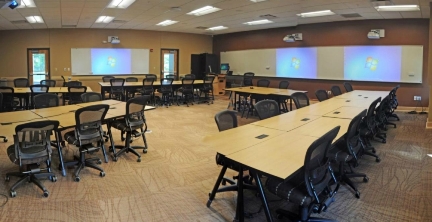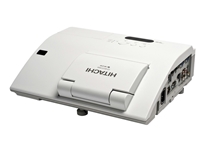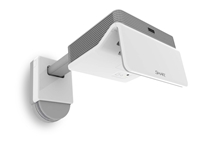Projectors Get Interactive
At Indiana Wesleyan University, interactive projectors have kickstarted collaboration in the classroom.
- By Dian Schaffhauser
- 02/12/14

Source: Indiana Wesleyan University |
The traditional role of a projector in the classroom seems to be beaming a PowerPoint slide onto the whiteboard up front, giving students something else to stare at besides the instructor's face. While that may be the norm, students have changed, and so should the job of the projector, according to Brian Hertzog, director of institutional media technologies (IMT) for Indiana Wesleyan University. When students come to class, he believes, "They want to engage with one another. They're yearning for that collaboration."
While constructing a new seminary building on campus, Hertzog and his IMT team wanted to try something different in one of the classrooms to facilitate collaboration. He turned to his vendors for advice, who recommended furnishing the space with a bunch of flat panel displays. After all, the university was already using those in other areas.
"That did not work for us," he recalled. "When you mount a flat panel on the wall, it destroys that space. You are set with a flat panel and nothing else is going to happen on that wall."
The crew also considered installing multiple interactive whiteboards, but the cost would be a lot more than the university could afford. So IMT came up with an alternative: cramming the walls with inexpensive, ordinary whiteboards. "Our seminary faculty are unique. They love to write. They will use any whiteboard that you give them," Hertzog explained. In conjunction with the whiteboards, five Epson BrightLink interactive short-throw projectors mounted above each wall serve the classroom's collaboration needs at a "fraction of the cost of interactive whiteboards," he said.
The use of projectors helped make the setup more flexible by preserving the traditional whiteboard space for offline work. Noted Hertzog, "Students don't have to use the projector, but if they do, it's still interactive, and they can do annotation, write all over it and it can all be captured, saved and e-mailed as a JPG."
Plus, unlike flat panels, these specialized projectors don't need remote controls that could "walk away" from the classroom; all controls are projected right on the wall.
After checking out projector models from a couple of vendors, IMT decided on the BrightLink in part because there's no software required for the interactivity, Hertzog said. "It has a built-in whiteboard, so you can turn it on, grab the pen and start writing. [With] other brands you have to install their software; you have to go through a few other things to get them to work."
Now, in a room outfitted with these projectors, students can break up into groups and congregate by a given projector to do collaborative work. Dual pens allow two students at a time to mark up the projected image. "It's as if they are working on a virtual whiteboard -- which they are -- and able to recall that work at any time. They don't lose their information. It's a pretty powerful tool," Hertzog said.
|
How It Works
An interactive projector adds interactivity to any flat surface. When the user drags a finger across the wall, for example, a line appears. Controls are displayed in a panel to the side and can be chosen with a finger poke. For more precision or setting color or other aspects of what's being written or drawn, "light," "smart," or "interactive" pens provide stylus and mouse functionality.
|
Expanded Use
The technology has been "a huge success" on campus, said Hertzog. Since the installation of interactive short-throw projectors in one classroom, the university has added 16 others throughout the campus. A new nursing and science building will add an additional 37 projectors, including some in classrooms that will remain open for student use when courses aren't occupying those spaces. "Students can come in and use that and collaborate with one another. It's different from giving them another space with a flat panel. It adds that extra collaboration piece," he explained.
IMT found use for interactive projectors in old buildings too. The music department occupies rooms with high ceilings and a lot of storage cupboards. Previously, projectors were held in place at the bottom of 20-foot poles. The interactive short-throw projectors could be mounted on the walls over whiteboards, a much simpler setup that gives music faculty instant collaboration features, noted Hertzog.
|
Software Tools for Group Sharing
In classes where you want multiple users to share the content from their laptops, tablets or smartphones on a single display, two solutions deserve a look.
Install Mersive's Solstice on a Windows 7 computer connected to the network, load client software onto user devices, have those users connect to the same network, and everybody can connect and share their individual content on the same screen (including content posted from the cloud). A "roundtable" mode gives everybody equal access for posting; a "podium" mode leaves display control in the hands of the presenter, who can approve or deny requests to add to the shared screen. Although edits can only be done by the person sharing the specific piece of content, updates are shown as they're made. The software works on projector displays, flat panels and video walls; there is no limit on the number of simultaneous users.
Tidebreak ClassSpot works similarly. The main software is loaded onto a server and the user devices run a client edition, allowing participants to share their device screens. The difference is that ClassSpot specializes in helping classes to shift between small group sharing and whole-room sharing. Multiple users can control the same screen simultaneously from their devices, allowing for interactive projector-like collaboration, including annotation. The materials shared during class are saved, allowing for students to download the archive or letting the teacher post the archived file to a content system. Users include the School of Law at the University of Missouri-Kansas City, Winona State University (MN) and the University of Southern California, among others.
|
Advice
Though Hertzog is a strong proponent of interactive projectors, he did not recommend dumping traditional models altogether. They still have a home in larger lecture rooms, for instance. He advised using the interactive short-throw models for spaces with 35 students or fewer, where the class can be broken into smaller groups for collaboration.
He also recommended testing the accuracy and responsiveness of the interactive projector as part of the evaluation process. Users want to be able to go to the surface and control their computers as they normally do -- without having to slow down their hand motions, he said.
"Buy one, just one. Put it on one room and encourage faculty to come in and take a look at it. I can guarantee you that you'll be buying and installing 20 within the next two years," Hertzog enthused. "We can't install them fast enough. Everyone wants an interactive short-throw projector for multiple reasons, because of the flexibility it gives them and the usability and the efficiency. It has been a wonderful tool in our classrooms."
|
Interactive Projector Roundup
|
|
| The Epson BrightLink interactive line has three projectors that vary by lumen count (2,500 to 3,100) and come in models for wall or tabletop use. The bundle includes two pens, which can be used simultaneously. |
 |
| The 5,000-lumen Barco Collaborate CRPN-52B projector allows for sharing from up to four devices, provided the company's ClickShare software is used. The software automatically adjusts composition and resolution. |
 |
| The BoxLight ProjectoWrite6 line of wireless, interactive projectors has three models that include 1.5 gigabytes of internal storage for multimedia display. Lumens run from 2,700 to 3,000. |
 |
| The 3,200-lumen Dell S500wi projector allows for "off-surface" interactivity through its rechargeable interactive pen, which allows people in the room to write on the screen from where they're sitting. |
 |
| Use Hitachi CP-AW2519NM short-throw 2,500-lumen projector with the company's Starboard software to project interactivity onto any surface. |
 |
| The 2500-lumen Smart LightRaise 60wi projector includes Smart Notebook software, which provides tools and resources for creating interactive learning content. |
 |
About the Author
Dian Schaffhauser is a former senior contributing editor for 1105 Media's education publications THE Journal, Campus Technology and Spaces4Learning.